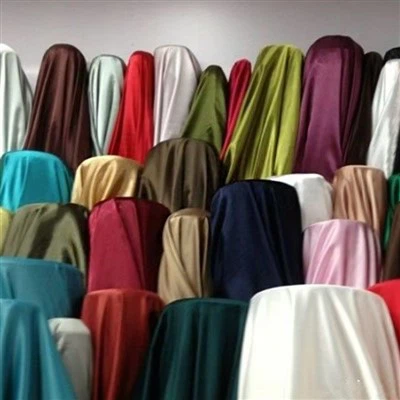Shiny Satin Fabric is a popular choice in the textile industry, renowned for its luxurious appearance and smooth texture. As a supplier of this exquisite fabric, I often encounter questions from customers regarding its shrinkage rate. In this blog, I will delve into the details of the shrinkage rate of Shiny Satin Fabric, exploring the factors that influence it and how to manage it effectively.


Understanding Shrinkage in Fabrics
Before we discuss the shrinkage rate of Shiny Satin Fabric specifically, it's essential to understand what fabric shrinkage is. Shrinkage occurs when a fabric changes in size after being exposed to certain conditions, typically during washing or drying. This change can be in length, width, or both, and it is usually expressed as a percentage. For example, if a fabric that is initially 100 cm long shrinks to 95 cm after washing, its shrinkage rate is 5%.
The shrinkage of fabrics is mainly caused by two factors: the relaxation of fibers and the structure of the fabric. Fibers in a fabric can be under tension during the manufacturing process. When the fabric is washed or exposed to moisture and heat, these fibers relax, causing the fabric to shrink. The fabric structure, such as the weave and the density of the fibers, also plays a significant role. Fabrics with a looser weave are generally more prone to shrinkage than those with a tighter weave.
Shrinkage Rate of Shiny Satin Fabric
Shiny Satin Fabric is a type of satin fabric known for its high luster and smooth surface. The shrinkage rate of Shiny Satin Fabric can vary depending on several factors, including the fiber composition, the manufacturing process, and the care instructions.
Fiber Composition
The fiber composition of Shiny Satin Fabric is a crucial determinant of its shrinkage rate. Shiny Satin Fabric can be made from various fibers, such as silk, polyester, and a blend of different fibers.
Silk Shiny Satin Fabric: Silk is a natural fiber known for its softness and luxurious feel. However, pure silk Shiny Satin Fabric can have a relatively high shrinkage rate, typically ranging from 3% to 8%. This is because silk fibers are more sensitive to moisture and heat, and they tend to relax and shrink when exposed to these conditions.
Polyester Shiny Satin Fabric: Polyester is a synthetic fiber that is widely used in the production of Shiny Satin Fabric. Polyester Shiny Satin Fabric generally has a lower shrinkage rate compared to silk. It can be as low as 1% to 3%. Polyester fibers are more resistant to moisture and heat, and they are less likely to shrink during washing and drying.
Blended Shiny Satin Fabric: Blended Shiny Satin Fabric combines the properties of different fibers. For example, a blend of silk and polyester can offer a balance between the luxurious feel of silk and the low shrinkage rate of polyester. The shrinkage rate of blended Shiny Satin Fabric depends on the ratio of the fibers. A fabric with a higher proportion of polyester will generally have a lower shrinkage rate.
Manufacturing Process
The manufacturing process also affects the shrinkage rate of Shiny Satin Fabric. Fabrics that undergo a pre - shrinking treatment during the manufacturing process will have a lower shrinkage rate. Pre - shrinking involves exposing the fabric to moisture and heat before it is sold, which allows the fibers to relax and reduces the potential for further shrinkage.
Some manufacturers use advanced techniques to minimize the shrinkage of Shiny Satin Fabric. For example, they may use heat - setting processes to stabilize the fibers and reduce the shrinkage rate. Fabrics that have undergone such treatments can have a shrinkage rate of less than 2%.
Care Instructions
The care instructions for Shiny Satin Fabric can significantly impact its shrinkage rate. Washing the fabric in hot water or using a high - heat dryer can increase the shrinkage. To minimize shrinkage, it is recommended to wash Shiny Satin Fabric in cold or lukewarm water and to air - dry it or use a low - heat setting on the dryer.
If the Shiny Satin Fabric is labeled as machine - washable, it is important to follow the manufacturer's instructions carefully. Some fabrics may require special detergents or gentle cycles to prevent excessive shrinkage.
Managing Shrinkage in Shiny Satin Fabric
As a supplier, I understand the importance of providing customers with fabrics that have a predictable and manageable shrinkage rate. Here are some tips on how to manage shrinkage in Shiny Satin Fabric:
Pre - Shrinkage Testing
Before using the Shiny Satin Fabric for a project, it is advisable to conduct a pre - shrinkage test. Cut a small sample of the fabric and wash it according to the care instructions. Measure the dimensions of the fabric before and after washing to determine the shrinkage rate. This will help you account for the shrinkage when cutting and sewing the fabric.
Proper Care
Following the proper care instructions is essential to minimize shrinkage. As mentioned earlier, wash the fabric in cold or lukewarm water and avoid using high - heat settings on the dryer. If possible, hand - wash the fabric to have more control over the washing process.
Storage
Proper storage of Shiny Satin Fabric can also help prevent shrinkage. Store the fabric in a cool, dry place away from direct sunlight. Avoid folding the fabric too tightly, as this can cause creases and potentially affect the fabric's structure.
Other Related Satin Fabrics and Their Shrinkage
In addition to Shiny Satin Fabric, there are other types of satin fabrics that customers may be interested in.
Imitation Acetate Satin Fabric: Imitation Acetate Satin Fabric is a synthetic alternative to acetate satin. It is known for its affordability and good draping properties. The shrinkage rate of Imitation Acetate Satin Fabric is generally low, similar to that of polyester Shiny Satin Fabric, usually around 1% to 3%.
American Satin: American Satin is another type of satin fabric. It is often used in the production of clothing and home decor. The shrinkage rate of American Satin can vary depending on its fiber composition. Polyester - based American Satin typically has a low shrinkage rate, while those made from natural fibers may have a higher shrinkage rate.
Conclusion
The shrinkage rate of Shiny Satin Fabric is a complex issue influenced by factors such as fiber composition, manufacturing process, and care instructions. As a supplier, I am committed to providing high - quality Shiny Satin Fabric with a predictable and manageable shrinkage rate. By understanding the factors that affect shrinkage and following the proper care instructions, customers can enjoy the beauty and functionality of Shiny Satin Fabric without worrying about excessive shrinkage.
If you are interested in purchasing Shiny Satin Fabric or have any questions about its shrinkage rate or other properties, please feel free to contact me. I am more than happy to assist you with your procurement needs and provide you with detailed information and guidance.
References
- Textile Institute. "Handbook of Textile Fibres." Woodhead Publishing, 2016.
- Morton, W. E., & Hearle, J. W. S. "Physical Properties of Textile Fibres." Taylor & Francis, 2008.






